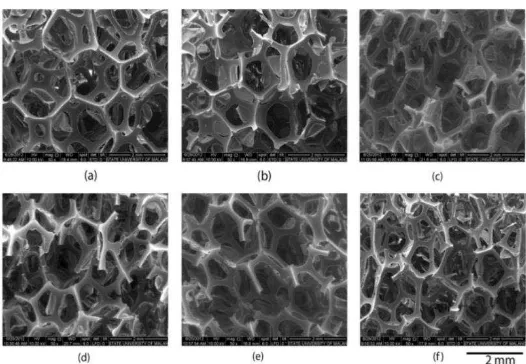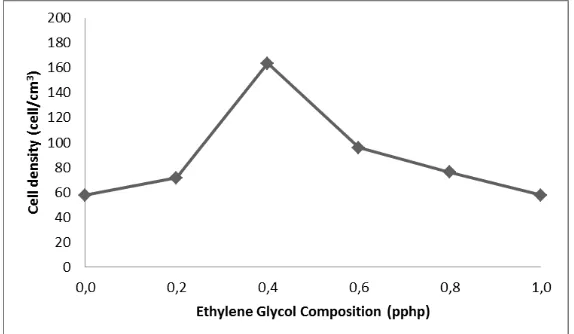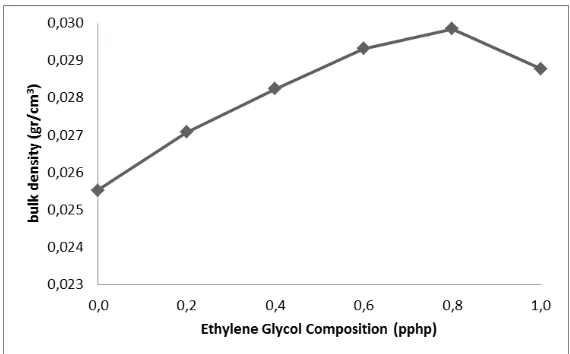Effects of Chain Extender to the Structure of Castor
Oil-Based Polyurethane Foam
Edhi Pratondo, Adityo Wahyu Hanggoro, Eva Oktavia Ningrum, and Sumarno
Chemical Engineering Department, Faculty of Industrial Technology, Sepuluh Nopember Institute of Technology Jl. Arif Rahman Hakim, Surabaya INDONESIA
E-mail: [email protected]
Abstract :
Polyurethane foam is cellular polymer that synthesized by chemical reaction between polyol and isocyanate. In this work we studied the effects of chain extender to the polyurethane foam structure that produced from polyol mixture consist of polypropylene glycol and castor oil (CO). This polyol would reacted with toluene diisocyanate (TDI) to produce urethane linkage meanwhile water and methylene chloride was added as chemical and pyshical blowing agent. A portion of chain extender ethylene glycol (EG) was added into the process as variabel proposed. One shoot process was chosen, thus ingredients was entered into stainless steel reactor consecutively followed by continuous mixing with three blade impeller. After foaming happened, liquid was pouring into wood-mold and curing at least for 48 hours. Characterization would determined such as bulk density, determination of diameter and cell density by Scanning Electron Microscopy (SEM). Functional group was analyzed by spectrum of Fourier Transform Infrared (FTIR). Result from FTIR analysis shows that adding chain extender ethylene glycol in making polyurethane based CO could improve foam structure by adding hard segment. In EG variation, minimum diameter was attained at 0,4 pphp. Furthermore cell density increased while upon 0,4 pphp it decreased and bulk density increased during adding of EG.
Keywords: castor oil, chain extender, polyurethane foam.
1. Introduction
Polyurethane (PU) is the polymer that resulted from reaction between isocyanate and polyol. Polyol is a term for compounds that have more than one hydroxyl groups (OH). If the compound has two hydroxyl groups are called diol, three groups are called triol and so on. Type of polyol that used commercially in the manufacture of PU derived from petroleum such as polypropylene glycol (PPG). Because of its limitation, natural polyol as an alternative material must developed. One of potential alternative materials was derived from the castor oil plant (Richinus communis). Castor oil is ricinoleic acid, which has three hydroxyl groups that can be used as polyol. Polyol from castor oil known as polyol that made from renewable vegetable raw material, it can be used for the manufacture of foam for various purposes [1].
Synthesis of polyurethane foam hold on two events that run simultaneously, gelation and blowing [2]. Gelation reaction is the formation of urethane groups, polyol and isocyanate. Urethane polyol connect to form longer chain structure resulting phase change from liquid to solid. Blowing reaction occurs between the isocyanate and water to form amine and CO2 gas. Amine will react further with isocyanate to form urea hard segment that
determines the hardness solid. While the CO2 gas as the blowing agent will trigger a bubble that ended in the cell
formation. Furthermore, blowing agent can be any compound that has a low boiling point, evaporate due to exothermic reaction heat.
Flexible foam PU has most applications [3]. Flexible foam cell structure characterized by interconnected with each other (opened cell). Any use of flexible foam having specific criteria. Therefore, some additional components (additives) are added to ensure the product generate the type of cell opened and the criteria are met. Some additive ingredients such as surfactant, catalyst and chain extender [4].
Several studies have been done in the manufacture of PU foam based castor oil. As [1] who conducted research on the manufacture of PU foam and polyol mixture of castor oil. Castor oil with a ratio greater than 20/80 of the polyol is not suited for cushioning applications. Semi-rigid foam is produced from 100% castor oil. Reference
2. Materials and Methods
2.1. Materials
Polyol that contain polypropylene glycol (PPG) and castor oil (CO) was obtained from Brataco Chemical. There are several additives used, ethylene glycol (EG) as chain extender, silicone glycol (SG) as surfactant, triethylene
Excess 8 % to total TDI required if complete reaction with polyol and aquadest
2.2. Methods
PPG and CO introduced into the reactor and then stirred by two pieces of 1-inch three-leaf blade. Then SG, distilled water (aquadest), TEDA, EG, and SO mixed sequentially with continuous stirring 135 rpm. Next, MC added and stirred for 10 seconds. Then TDI was added with stirring 270 rpm for several seconds. Finally the mixture was poured into a mold-wood and curing for 48 hours.
2.3. Characterization
Fourier Transform Infrared:Structure molecule and intra-molecul bond contained in the polyurethane can be observed by spectroscopy Fourier Transform Infrared Spectroscopy (FTIR). Resulted test performed readings of the FTIR spectrum that will be known the existence of clusters of molecules and the bond contained in the foam.
Determination of Diameter and Cell Density: Foam sample was broken by assistance of liquid nitrogen. Cellular structure was observed from the Scanning Electron Microscopy (SEM) image at 10 kV magnification 50 times. Perimeter of the cells was measured manually with ImageJ software. Individual cell size (diameter) was calculated by approached of each cell as a circle.
Cell density is determined as the number of cells per nucleated unit volume by the following equation:
2
Bulk Density: weigh several foam samples at certain dimension (3 x 3 x 3 cm) and determine its average.
3. Result and Discussion
3.1. Effect of Chain Extender in Molecular Structure
The increase in the CN stretch is characterized by an increase in sharpness linkage peak at a wavelength of 1222-1225 cm-1 as indicated in Figure 1 on the addition of ethylene glycol. Besides the form of solid urea is found only at 1650 cm-1 while at wavelengths from 1715 to 1710 cm-1 peak was not found. This indicates the formation of urea linkage bond more with the addition of the polyurethane foam of ethylene glycol.
Figure 1. Result of FTIR spectra in the composition of ethylene glycol at 0,0 pphp; 0,4 pphp and 0,8 pphp
Figure 2. SEM photos of cured polyurethane foam magnification 50 times on the variation of ethylene glycol composition: (a) 0,0 pphp (b) 0,2 pphp (c) 0,4 pphp (d) 0,6 pphp (e) 0,8 pphp and (f) 1,0 pphp
3.2. Effect of Chain Extender in Cell Diameter and Density
Average cell diameter can be calculated from the SEM image in Figure 2 and cell density can be obtained by counting the number of cells in the area of the photo. Cell wall is formed from the reaction between the isocyanate with the polyol gelation. In the use of castor oil as a polyol, cell wall formation is slower and larger cells formed due to the low reactivity of castor oil. Cells that are formed can be controlled with the addition of EG. The addition of EG to extend the hard segment is formed so that the cell wall is stronger and formed cell becomes smaller.
indicates the cell wall strength is still not able to withstand the bubble growth due to the lack of hard domains in the cell wall. In the composition above 0,4 pphp the higher the heat of reaction due to the increasing number of reactants. If there is a bubble that had been formed because of the stirring, methylene chloride blowing agent which is volatile expanded cells stimulated to more rapid.
Figure 3. Effect of chain extender to the cell diameter
Diameter of the cell affect the number of cells in one area. Where increasing numbers of cell diameter the fewer number of cells in one cm3. Can be seen in the SEM images, the number of cells formed increased as the addition of ethylene glycol. In other words, the cell diameter is inversely proportional to cell density as shown in Figure 4. Inconsistency of cell diameter and cell density shows poor in mixing.
Figure 4. Effect of chain extender to the cell density
3.3. Effect of Chain Extender in Bulk Density Foam
Figure 5. Effect of chain extender to the bulk density foam
4. Conclusions
There are conclusion based on analysis has been done.
Adding chain extender ethylene glycol in making polyurethane based CO could improve foam structure by adding hard segment.
In EG variation, minimum diameter was attained at 0,4 pphp.
Cell density increased while upon 0,4 pphp it decreased.
Bulk density increased during adding of EG.
Recommended ethylene glycol composition is at 0,4 pphp.
Acknowledgement
Ministry of National Education Republic of Indonesia which has provided financial support through the Student Creativity Program for Research (PKMP).
References
[1] Ogunniyi DS, Fakayejo WR, Ola A. 1996. Preparation and Properties of Polyurethane Foams from Toluene Diisocyanate and Mixtures of Castor Oil and Polyol. Iranian Polymer, 1 : 56-59
[2] Kaushiva BD. 1999. Structure-Property Relationships of Flexible Polyurethane Foams. Ph.D. dissertation. Dept. Chemical Engineering. Virginia Polytechnic Institute and State University. Blacksburg. VA
[3] Petrović ZS. 2005. Polyurethanes, in Handbook of Polymer Synthesis, 2nd. edited by Kricheldorf HR, Nuyken O, Swift G.
New York: Marcel Dekker
[4] Artavia LD, Macosko CW. 1994.Polyurethane flexible foam formation, in Low Density Celullar Plastic, 1st. Edited by Hilyard NC, Cunningham A. London: Chapman & Hall
[5] Rahmawati TI, Wardana IWL. 2012. Lab. Teknologi Material, ITS Surabaya, personal communication


